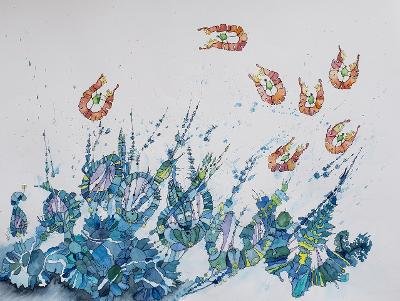
There are two loves in my life, two passions on which I spend countless hours. On one side the world of science, biology, physiology, cells and smells, counters with a microscope, computers with software for statistical analysis. On the other side is the world of painting, composition, shapes and structures, tables with brushes, tubes filled with pigments, and the scary white surface that waits to come alive with colors and lines.
I believe that art and science have always gone hand-in-hand. My work resembles biology. I like to mimic the biological processes and allow the lines and shapes on paper to grow and develop naturally.


Science was my first love, a reliable way to learn about the world. My first superheroes were scientists, taking on the unknown and often the rich, religious, and established. I studied computer science and biology. I remember the days of math, of learning processes happening in our organs, tests, exams, successes and failures. In the evenings, my brain full, done absorbing facts, done reading, done learning, done analyzing. I felt mentally and emotionally overfilled. I needed an outlet. I needed to produce something, thinking creatively, productively, and something that comes out of me. That is when I started to draw. People and faces from photos, postcards, calendars—from all over the world, in black and white.


Fast forward about ten years. I reached a certain skill level producing these photorealistic pictures, but the process became predictable and sometimes tedious. Visiting München in Germany, I went to the Lehnbach Haus, a museum/gallery that back then held only expressionist paintings by the Der Blaue Reiter group. I went from paintings by Alexey von Jawlenski to those of Wassily Kandinski, standing for minutes in front of paintings of Paul Klee and Gabriele Münter. I fell in love with the work of August Macke and Franz Marc. I knew their works before, but for the first time I saw many of the originals. What an amazing, beautiful, colorful adventure.
The very next day I purchased colors and hardly ever looked back to black and white. Instead I started several years of learning, experimenting, and discovery about how to use my own color language. Initially I was timid, worked in small scale, usually postcard sized images, and only applied color faintly, but over the years I grew bolder. I started pictures without a concrete plan, just with a line or a small colored patch, and from there the picture developed in a sort of dialogue.

I love the freedom of form, color, line . . . not bound to represent objects. Most of my artworks start with a line or two, sometimes a simple shape. From this humble beginning, lines grow out from small inaccuracies and thus more shapes and shades are added; therefore in a nearly biological process, following my own rules (for example, no straight lines, lines hardly ever cross or split in an angle of ninety degrees) organic shapes develop and grow.
My overall goal is to have the drawing end in a visually balanced and aesthetically pleasing design. Many of my designs are influenced by biological patterns as seen through the microscope. I love discovering this microcosm, usually not even noticed by most, and make it part of my design, a series of pictures depicting my own fantasy world, cities, houses, trees, animals, underwater worlds with no end in sight. It is exciting not to know what there is to be discovered in each new painting. In this process of growth and discovery while painting my pictures, that makes me most happy.


After another eight years. I was able to take classes at the university I worked as biologist learning painting and drawing with the art students. Clear expectation: paint twelve to fifteen hours every week. Twelve hours of painting besides a full work schedule in the sciences was no longer always fun. That demands scheduling, keeping deadlines, working hard to achieve goals. Nothing else has pushed my own art forward more than painting beyond the level of enjoyment and entertainment. To get better, you have to paint a lot and then some. My pictures became larger and more complex.

Where do you need to grow? Where do you want me to add? The shapes and patterns came from my work with the microscope. Cells, tissues, nerves, blood vessels, certain patterns appear with regularity under the microscopes and I use similar patterns in new combinations. Biomorphic fantasies.



My approach today resembles biological growth processes more than ever. How does a tree grow? There are instructions in every cell, DNA code that in the end determines branching patterns, shapes of leaves, or how long to grow and when to slow down. Not fixed rules but the tree has to apply those instruction while interacting with its environment. Nutrition, rain, wind, rocks, interactions with other organisms . . . all that influences how the tree applies in inherent basic rules.

So in the end, a birch tree is recognizable as a birch tree because it followed its rules how to make a tree, but no two birch trees in the world are the same because of the interactions with the environment and some chance events. My painting follow certain rules, often unconscious, and some random interactions with the environment I create. Recognizable as my art, and no two the same, often not even similar.

Share this post with your friends.

